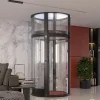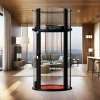How does an elevator work?
An elevator consists of Cabin & rail with two types of lifting system. The two main types of lifting systems are called: the hydraulic and traction.
Hydraulic elevators are powered by a hydraulic jack, which are fluid-driven pistons that travel inside of a cylinder.
Traction elevators are composed of steel ropes or belts on a pulley system with counterweight.
Modern freight and passenger elevators are a lot more complicated than this. They require advanced mechanical systems to handle the significant weight of the elevator room and its load. Additionally, they need a control system so passengers can operate the elevator accordingly.
What is a hydraulic elevator?
Hydraulic elevator systems lift an elevator roomwith the use of the following: hydraulic ram and fluid-driven piston mounted inside a cylinder.
Hydraulic systems do not use overhead hoisting machinery. Instead, it uses the compression of fluids to produce movement. The System should have a separate room adjacent to the shaft at the lowest floor.
The elevator room is lifted by an electric motor that pumps oil into the cylinder to move the piston. Hydraulic elevators also incorporate electrical valves to control the release of oil for a smooth ride.
Hydraulic Vs Traction Elevators
Traction elevator room is raised and lowered by traction steel ropes or belts on a pulley system. Compared to hydraulic systems, the traction elevator is energy efficient, ideal for mid – high rise building and has a more comfortable ride.
Hydraulic elevators require a considerable amount of energy to raise the elevator room, which is why they are not usually found in high-rise buildings. These systems also operate at speeds of 150 ft./min. or less, thus making them slower than other types of elevators.
PROS
- Do not required over head machine room
- Minimized elevator hoist-way dimensions
- Aesthetically more pleasing If panoramic. This is because there is no steel rope nor counterweight to make the lift look bulky.
- Installation costs are typically less than with other elevator system
CONS
- A machine room is required for pump unit and other control components
- Limited speed. Up to only 0.6 M/S
- Higher noise levels caused by the pump and hydraulics
- Non eco-friendly due to hydraulic oil leaking into the ground
- Quality of ride is less than of Traction Lift. Jerking and bounciness in cabin is common in Hydraulic Lifts.
Types of Hydraulic Elevators
Holed Hydraulic
Elevator room is mounted on a piston that moves inside a cylinder. The cylinder extends into the ground to a depth equal to the height which the elevator will rise. The elevator room rises as hydraulic fluid is pumped into the cylinder through a valve and as the fluid returns to the reservoir, the elevator room descends.
Hole-less Hydraulic
Elevators of pistons set inside the hoist way to raise and lower the elevator room. This is a solution for buildings built on a high-water table, abedrock,or unstable soil conditions or any locations that requires digging a hole for a conventional hydraulic elevator impractical.
Roped hydraulic elevator
This is also known as indirect acting lift.This type of hydraulic elevator extends the rise of the hole less elevator to 18mwithout the need for an underground cylinder. Roped hydraulic elevator systems have the piston attached to a sheave in which a rope is passing through it. One end secures the bottom of the hoist way and the other end is attached to the car. Roped hydraulic systems also require an over speed governor. This is because the rope is holding the car up, and there is a risk of the car free falling when the rope breaks.








